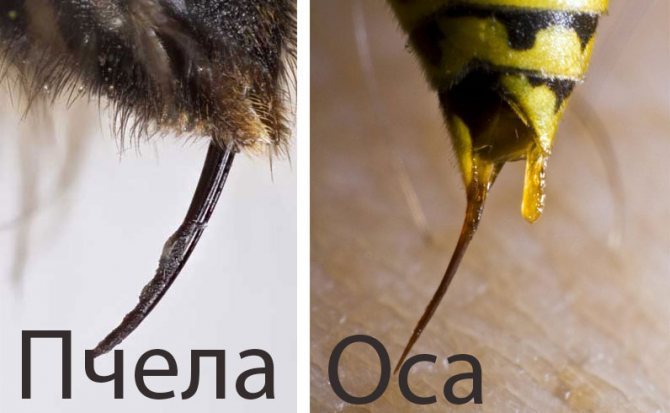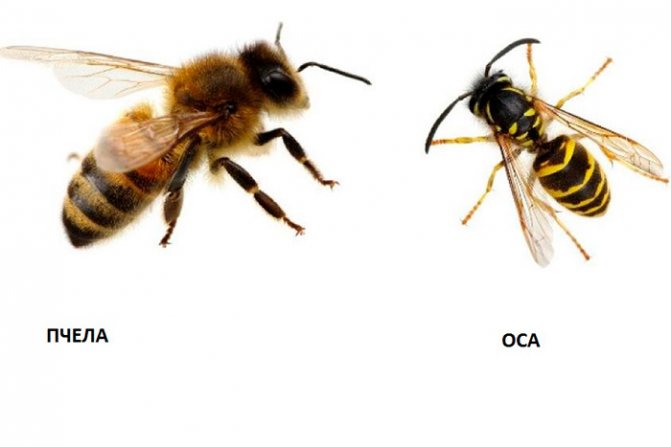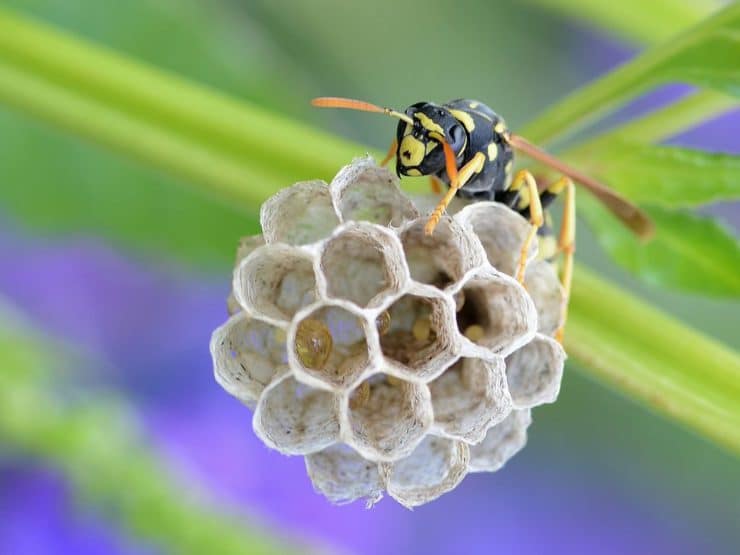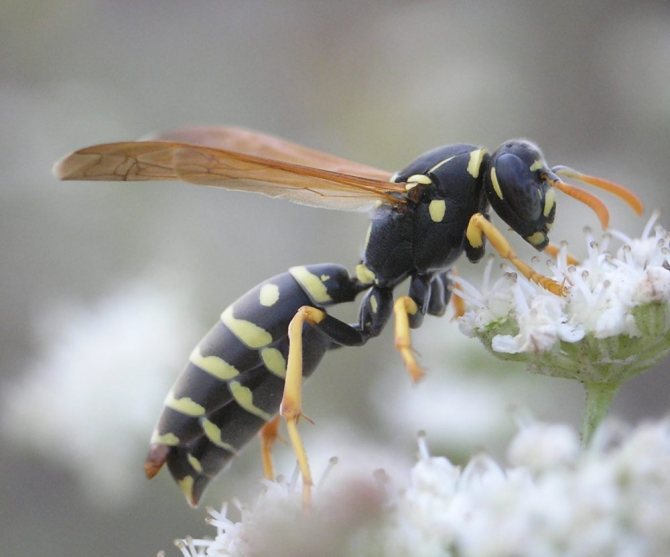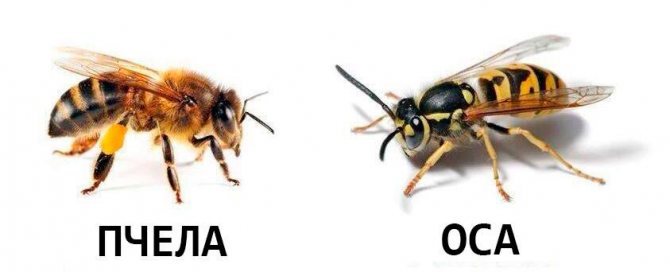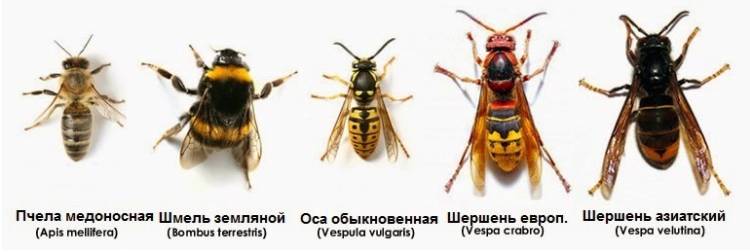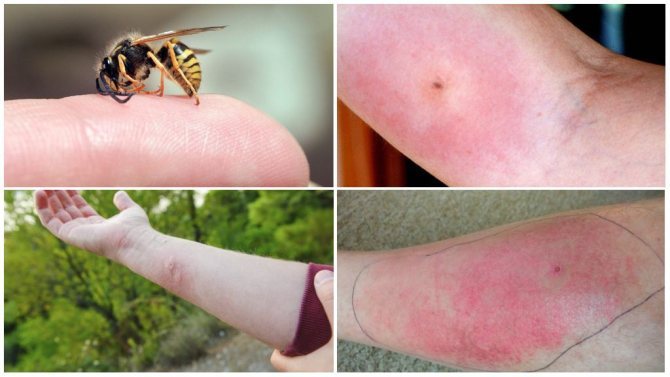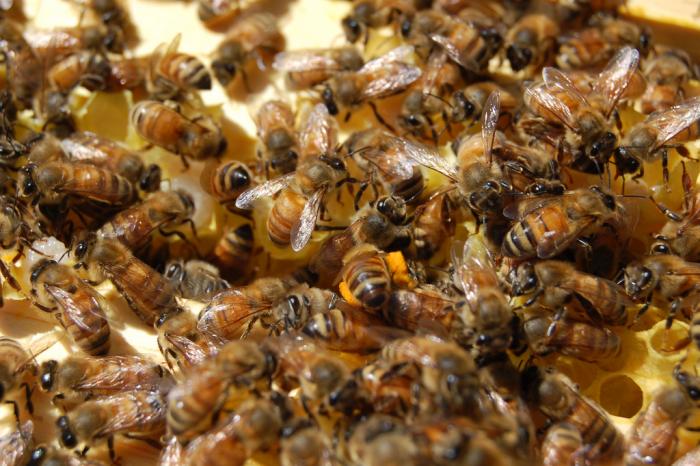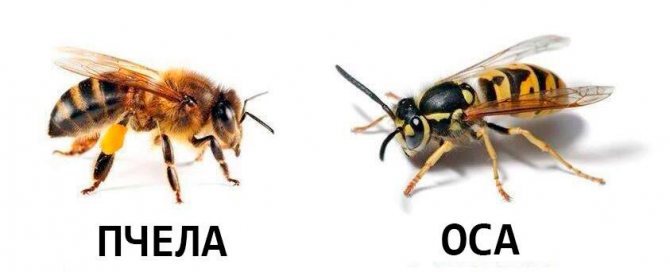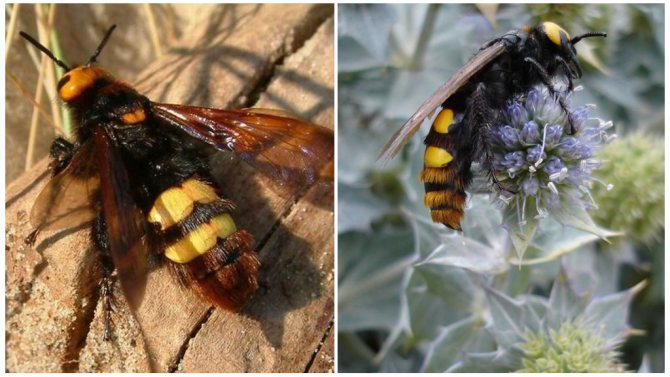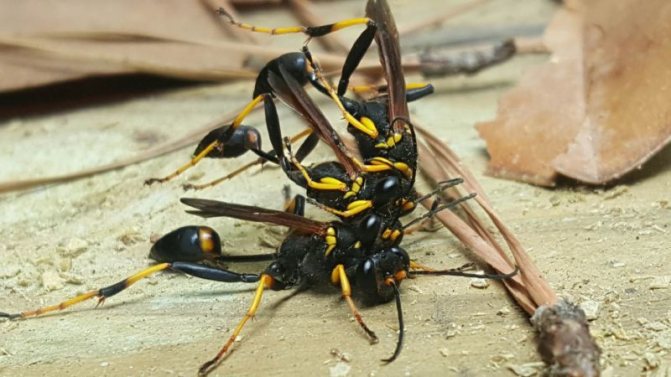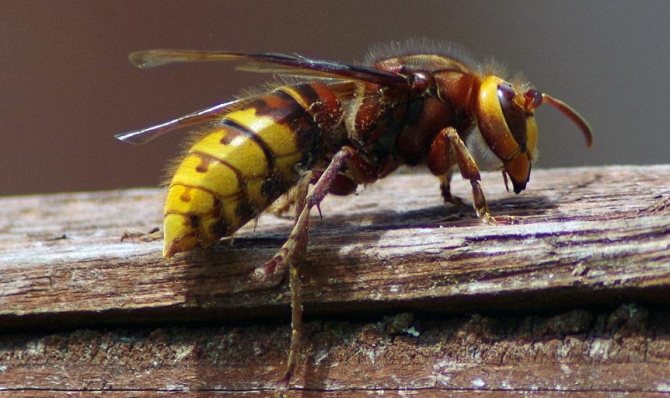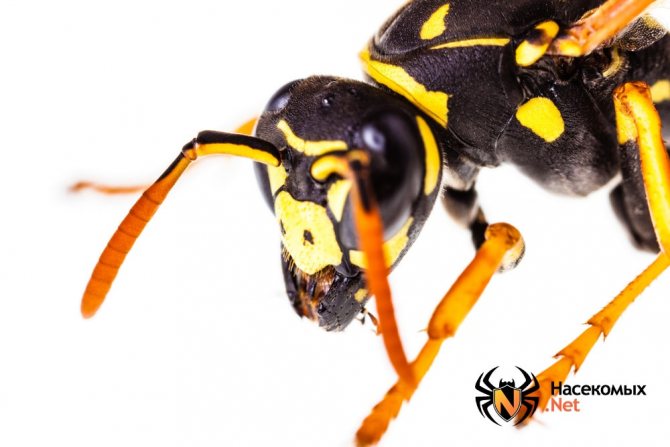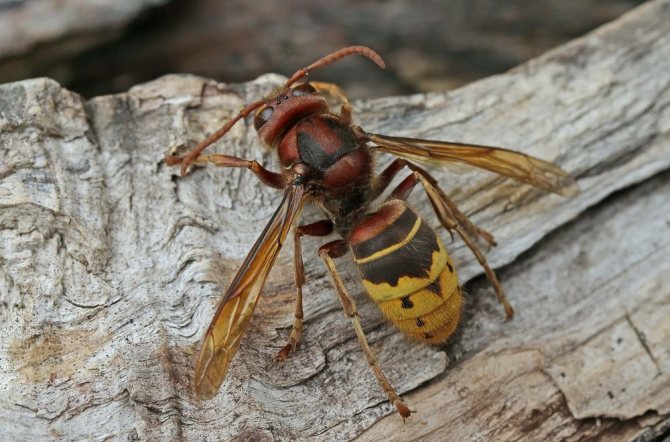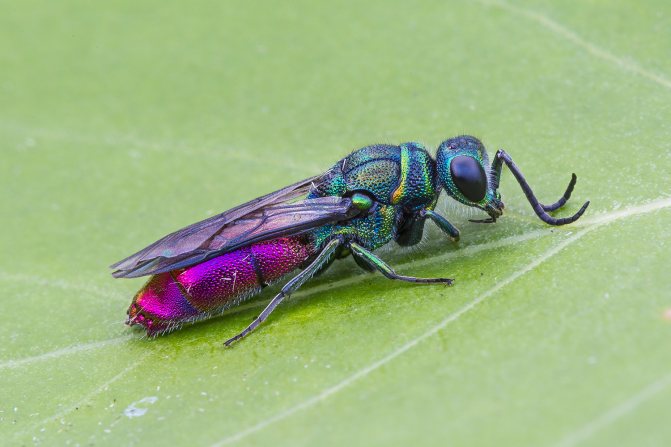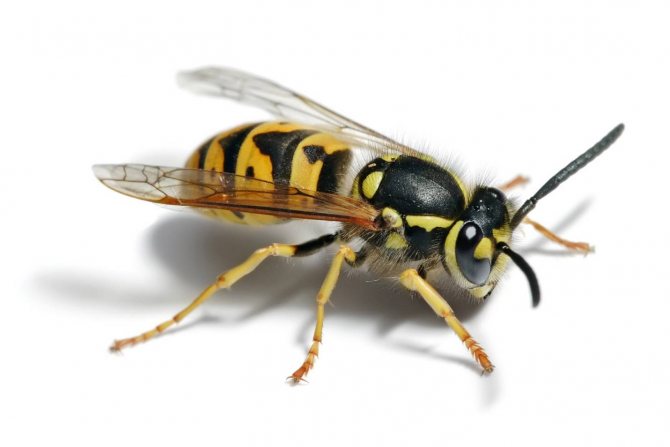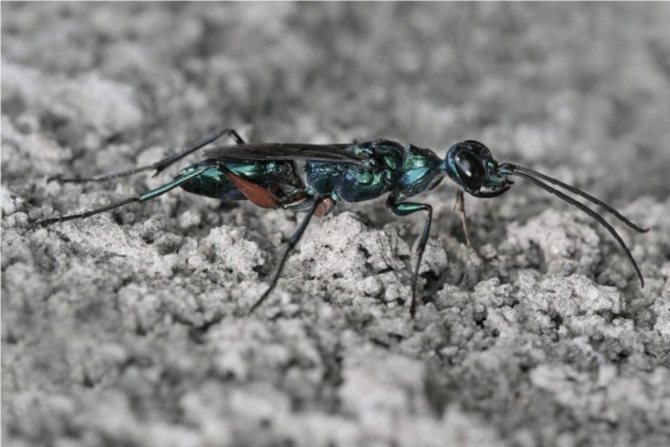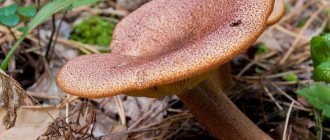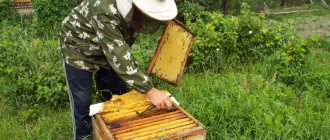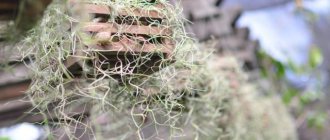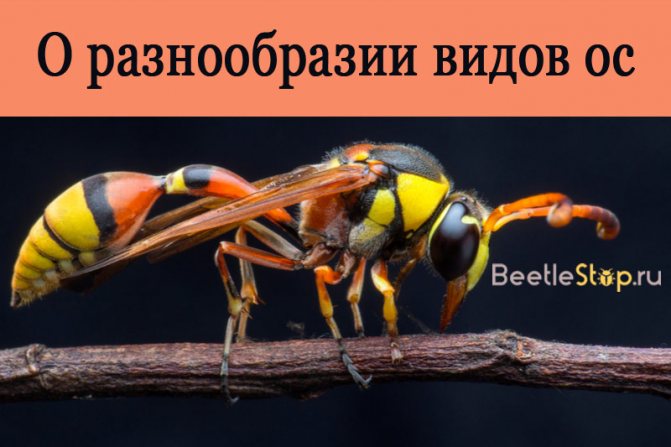
At the mention of wasps, an association arises with an annoying insect with a striped black and yellow abdomen. In fact, there are a huge number of them. Representatives of families differ in size, body structure, and breeding characteristics. All types of wasps share a love for sweet fruit juice, nectar and fermented drinks. Insect females actively take care of the offspring, devoting the main part of their lives to this.
Habitat and livelihoods
Wasps and bees differ primarily in their habitat. Bees can be found in flowering, flooded meadows. They are the most welcome guests of the spring garden. A good harvest is largely their job.
Wasps are more willing to eat fruits, berries, sweets. And not necessarily fresh. They can be confidently found on rotting food waste. Given this feature, you need to be careful. They carry bacteria and fungi. Become a source of infection for healthy plants.
There are differences even in the larvae: the workers feed their own with honey, royal jelly and pollen, and the aggressors need protein. For this, other insects are destroyed.
Seeing a wasp next to the hive, beekeepers begin to take protective measures. Otherwise, you can lose precious families of workers.
Bees are laborers by nature. They are ready to work endlessly for the good of the hive. Collecting nectar from flowers, bees produce many useful products that are used in pharmaceuticals and human nutrition. Honeycombs are built from the wax they produce.
Wasps are not able to develop any useful product; they make their hives from a variety of waste. Wasp food is quite varied. They do not disdain either fruit or nectar. The diet of wasps also includes delicacies, which include flies and other small insects.
What does the insect eat
Hornets feed on nectar and plant foods that are high in sugar. Among insects' preferences are ripe fruits, berries, flower nectar, honey and tree sap.
At the same time, hornets are predators. They hunt insects to feed their larvae. With the help of a sting and powerful jaws, the hornet easily copes with flies, horseflies, gadflies, bees, wasps, grasshoppers and locusts. He completely chews the prey and feeds it to the larvae.
External differences
It must be said that from some distance it is not always possible to say with certainty what kind of insect is flying, a bee or a wasp. Still, both species (and in this review we will consider and compare exactly the species, using the common wasp and the honey bee as an example) belong to the same order of Hymenoptera, and naturally, they cannot differ in the same way that a grasshopper differs from a butterfly.
Stinging insects.
But, in fact, these two types of insects do have much more different than in common. And this statement applies to both their essence and lifestyle, and external characteristics.
So, what is the difference between wasps and bees.
Let's list the main differences, and these include:
- body shape;
- the thickness of the transition between the thoracic segment and the abdomen;
- presence / absence of body hair of insects;
- the thickness of the legs;
- body coloring.
Now let us explain each of the above points.
Perhaps one of the main features of all wasps that distinguishes these insects from others is their so-called "waist", comparison with which has long become a catch phrase. Indeed, in the structure of its body, the predator has a very narrow transition from the thoracic section to the abdomen.
Also, a bee is distinguished from a wasp by the presence of a very noticeable thick hairline, especially on the thoracic segment of the body. The wasp, on the contrary, does not have visible hairs on its body, its body is smooth.
Bees have fleshy, so to speak, black legs. In wasps, the limbs are usually yellow, they are also longer and thinner than that of a bee.
Finally, both types of insects have very different body colors, especially the coloring is a characteristic distinguishing feature of the wasp. If you look very close at representatives of both species, it is impossible not to identify the striped predator.
Its bright black-yellow color, together with a predatory expression of "face", betrays a stinging killer in it much more clearly than a stinging hymenopteran insect, which is also able to stand up for itself, can be identified in a calmer and more comfortable appearance of a bee.
Despite the fact that both species have a gnawing-licking mouth apparatus, the wasp still has much more impressive mandibles, which emphasizes the aggressiveness of the species and its focus on fighting and attacking.
Variety of wasps of Russia
In Russia, there are representatives of single and social wasps. 8 species of hornets belonging to the genus Vespa have spread throughout the country. The common hornet lives in the European part, Siberia, Transbaikalia, Primorye. The size of the female is up to 35 mm, workers are 2-24 mm. In the Amur Region and Primorye, you can find the Black Hornet and the largest representatives of this species. Among them is Vespa mandarinia. Females of this species have a body length of 43-55 mm, males 30-40 mm. Adults feed on fruit juice, larvae are fed on meat food.
Among social wasps, there are species that build nests in the ground (Austrian, Germanic and red) and on branches (forest, Norwegian, Saxon). Representatives of the genus Polist, building their nests without an outer shell, are noted in the south of the European part, in Siberia, Altai and Buryatia.
Solitary wasp species of Russia include insects that build nests in various cavities. An egg and a paralyzed victim are laid in them, on which the larva will parasitize. It can be a fly, beetle, caterpillar. The sizes of representatives of this species do not exceed 11-14 mm. Several species living in the Crimea and the Caucasus make nests in the ground. Insects related to pill wasps make nests out of mud in the form of jugs. An egg and several caterpillars are laid in them to feed the offspring.
Behavior in stressful situations
In case of danger, bees sting, but only if they are attacked first. In this way, they protect the hive. After the bee has stung, it dies, leaving a sting in the opponent's body. There is a certain hierarchy in the family of bees, the highest level in which is the queen bee. It is her welfare that the worker bees take care of. In winter, all the conditions for a comfortable existence are created for her.
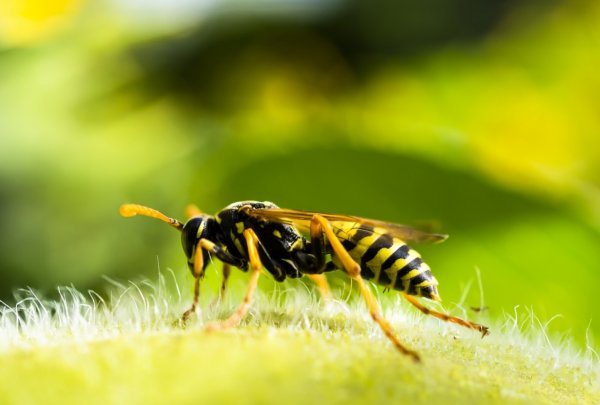

The wasp is a rather aggressive insect. Its characteristic features are intrusiveness and the ability to sting at any moment. At the same time, the wasp does not die. In addition to the sting, the wasp uses a jaw apparatus to defend against opponents, which, in principle, is uncharacteristic for insects of its family. The wasp queen spends the winter alone, she has no helpers and guards. Alone, she lays the larvae and builds a nest.
The average person may not be interested in such subtleties. Differences of an applied nature are much more important. For example, when do they start biting? Who leaves the sting: a wasp or a bee? How to behave nearby?
A flower lover, unlike her close relative, will begin to bite only with a direct threat to the uterus or through physical contact. Do not climb into the hive - it will not lead to good. It is also dangerous to pick them up without preparation.
Wasps are unlikely to observe such piety towards humans. Any sharp wave of the hand or movement close to a potential source of food will already be a signal to attack. The wasp is characterized by unmotivated aggressiveness. This is the main difference in behavior. In addition, she does not lose the sting and will easily return to bite a couple more times.
We suggest that you familiarize yourself with: Benzyl benzoate remedy for lice and nits
Building a nest
Wasps build their nest, as a rule, together, but only the female, the founder of the entire colony, is always engaged in its initial construction. She also feeds the first hatched larvae. From these larvae, working individuals subsequently grow, which help the female in further construction.
Females begin to build a new nest in early spring, immediately after waking up from winter sleep. Having got out of its hiding place, the founding wasp flies in search of a place suitable for a nest - it must be protected from wind, direct sunlight and prying eyes. Often they stop their choice on a branch of a tree with a dense crown, an abandoned building, the attic of a private house. Sometimes construction can begin even on the surface of a large stone, in an abandoned burrow of some rodent, in a rotten stump, a hollow of a tree or behind the cladding of a residential building.
The first "brick" of the wasp nest is a thin thread of solidified sticky secretion, which the female attaches to the selected surface. Further, this thread gradually turns into a well-distinguishable "leg", to which the first two cells are first attached, and then the whole structure.
Lifestyle
Bees and wasps share only one mode of existence that is common to most Hymenoptera, including ants and bumblebees. Both the wasp and the bee are social insects, the main life purpose of which is to take care of the hive in bees, and to provide the colony with food and protection in the wasps.
Bees.
At the same time, nevertheless, here there are more differences between these two types than in common. Bees are much more sharpened for taking care of the hive, they tend to invest their whole life on the altar of the safety of the larvae and the uterus.
Wasps, being predators and aggressors, not only protect their colony, larvae and their queen bee from outside encroachments, but they themselves quite often carry out attacks on other social insects, such as bees or ants.
Wasps never attack bumblebees, because this predator cannot cope with such a large enemy, unless it is a hornet. But with bees, wasps arrange real massacres, in which wasps, more adapted to aggression, often win.
Reproduction of a large spotted scolia
The mating season is limited, as in many species. Young adults mate in May. In June, the female is busy laying eggs, obtaining food for the larvae. By the end of summer, the female is already planning prey, which will become food and a place for development for young offspring.
The fertilized female digs a burrow in the ground, drags a paralyzed victim there, lays an egg on its abdomen. He gets out, covers the entrance with earth. Each larva requires a separate burrow, its own prey. Further development, maturation of the offspring occurs without the participation of the female.
Interesting!
The larva begins to eat the prey from the least important organs, leaving it alive for a long time. In the last turn, the circulatory and nervous system is damaged. At the end of its development, it weaves a cocoon, pupates, in this form it remains to winter. In the spring, young females appear, males ready to mate.
How to distinguish bees from wasps by their appearance
There is a legend that the devil created the wasps, and God created the bees. According to the legend, it is thanks to the blessing that bees guard human health, supplying such important and necessary components of many medicines as honey, wax, propolis. Wasps, at least, are referred to as useless creatures, and as a maximum, to pests. And, nevertheless, the similarity of these two insects leads to confusion, which we have to figure out.
Appearance
If you ask a child who is in front of him, a wasp or a bee, he is likely to get confused. But adults are often unable to distinguish between a bee and a wasp. And, nevertheless, there are many external differences in these insects.
They look like this: the body is somewhat rounded, covered with villi. The bee, like many similar insects, has yellow-black stripes on the body, muted color.
Wasps do not have a strict scientific definition; they include those from the suborder stalk-bellied, which cannot be attributed to bees or ants. Wasps have a long body, which is pulled over the chest. The body of wasps is smooth, without fibers. The color of the wasp is similar to that of the bee - the same stripes, but only bright, noticeable.
Life activity
Bees are laborers by nature. They are ready to work endlessly for the good of the hive. Collecting nectar from flowers, bees produce many useful products that are used in pharmaceuticals and human nutrition. Bees make honeycombs from the wax they produce.
Wasps are not able to develop any useful product; they make their hives from a variety of waste.
Wasp food is quite varied. They do not disdain either fruit or nectar. The diet of wasps also includes delicacies, which include flies and other small insects.
Behavior
In case of danger, bees sting, but only if they are attacked first. In this way, they protect the hive. After the bee has stung, it dies, leaving a sting in the opponent's body. There is a certain hierarchy in the family of bees, the highest level in which is the queen bee.
It is her welfare that the worker bees take care of. In winter, all the conditions for a comfortable existence are created for her. The wasp is a rather aggressive insect.
Its characteristic features are intrusiveness and the ability to sting at any moment. At the same time, the wasp does not die. In addition to the sting, the wasp uses a jaw apparatus to defend against opponents, which, in principle, is uncharacteristic for insects of its family. The wasp queen spends the winter alone, she has no helpers and guards. Alone, she lays the larvae and builds a nest.
conclusions
- The bee has a more rounded body. The cover has villi, the color is muted. The wasp, on the contrary, has a smooth elongated body and bright colors.
- Bees produce useful products: wax, honey, propolis. Wasps do not produce any useful foods.
- Bees are not the first to attack, wasps are predators by nature, they are able to sting for no apparent reason.
- After the bee stings, it dies. Wasps are capable of stinging multiple times, and in addition they bite using the jaw apparatus.
- Bees feed exclusively on pollen, while the diet of wasps is more varied.
- The queen bee is surrounded by the care of other members of the family, while the wasp queen is forced to take care of herself on her own.
Externally, the bees have a rounded striped body. As a rule, the stripes are black and muted yellow, brownish. In wasps, the body is elongated and pointed, and the stripes are much brighter. Also, bees have a shaggy body, but wasps do not. The main difference between a bee and a wasp is that the latter do not carry honey.
There is an opinion that bees are beneficial insects, as they carry honey, and wasps are pests that can only sting. In fact, this is not the case, each insect has its own useful functions.Wasps, for example, exterminate really harmful insects; wasps feed their future offspring with them.
Both wasps and bees can sting. True, bees are not so often found in the city, as they live near flower fields.
We suggest that you familiarize yourself with: In case of a bee sting, it is necessary to attach to the place
By the way, about 80% of all plants are pollinated solely thanks to bees. A bee can sting only once in its life, since there is a hook at the tip of its sting, because of which it cannot get the sting from the victim's body. Wasps can sting many times, and they also bite with their jaws.
The semantics of the names of the varieties of wasps and bees is quite fascinating. For example, social wasps are called that way, because they live as a whole society, with their own charter and hierarchy. Also, these wasps are called paper, since they build their houses from paper.
This is the name of the honey bee for obvious reasons. There are also mason bees who build their houses from real cement. Bees rarely enter human habitation, as they feed exclusively on pollen. Wasps are attracted to human food: honey, fruits, juices and even meat, which they carry to the larvae.
It is very important to know how to distinguish a bee from other insects, since bee venom contains acid, which can be neutralized with alkali, for example, by soaping the bite site. Aspen poison contains alkali, and you need to neutralize it with acid, for example, vinegar.
Bee venom is even useful, as it can treat diseases of the nervous and circulatory systems. It also increases the level of hemoglobin in the body.
Despite the fact that the bites of these insects are quite painful, they rarely cause complications and problems. The only exception may be an allergy to the components of bee and wasp venom.
Bees rarely bite just like that, but wasps can attack first, since they are predators by nature. In addition to honey and poison, bees produce wax that is useful and necessary for humans. Wasps destroy pests such as flies. That is why these insects should be protected.
The bee's body is covered with a continuous cover of soft hairs, and the wasps are almost naked. Bee legs are adapted to collect pollen; wasps do not collect pollen.
The color of the body is an important feature by which insects can be distinguished. Wasps have bright yellow stripes on the torso and head. Bees have stripes on the body of a more muted brownish-yellow hue.
Also, insects differ in body structure: in wasps, it is long, overtightened in the chest area. Bees have a more rounded body.
Bees and wasps differ in behavior tactics, food nature and community structure. On the back pair of legs, the bee has pollen baskets to carry pollen.
She flies through fields and meadows in search of flowers. The collected nectar and pollen are taken to the hive. Bees are social insects, they live in numerous families, wasps are small-family creatures, they do not store nectar in their nests.
Sting features
In worker bees and wasps, the sting has a protective function. In the queen bee, the sting is used for protection and oviposition. A bee sting resembles a harpoon with hooks pointing backwards.


Be sure to read:
What a queen bee looks like: description, stages of development, when replacement is necessary
Once in the skin of mammals, it gets stuck there. Wasp and bumblebee have a smooth sting without serrations. They calmly take it out of the wound. They can, sensing danger, sting a person several times until the entire supply of poison is consumed.
Leaving a sting after a bite, the bee, along with it, loses the poisonous gland, muscles and nerve nodes associated with it. This achieves the maximum effect: under the action of nerve impulses, the poisonous gland contracts, and its contents completely enter the wound.
The bee flies away and, depending on how seriously damaged the internal organs of its abdomen, lives for some time. After being bitten, she usually dies immediately or after a week.
Wasps sting several times when attacking, their flight is swift, because they are hunters. It is important for them to quickly immobilize their prey, so they sting several times in different places until the prey dies. Then they take it to their nest and walled it up in a cell with an egg.
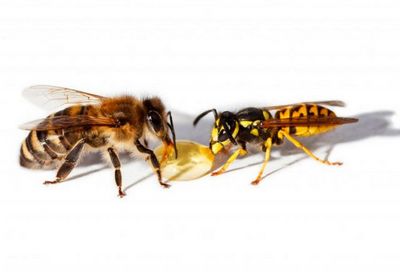

Bees are nectar gatherers who store honey in their nests. Bee colonies feed on honey in winter, and feed their offspring with pollen and nectar.
Adult wasps hunt other insects or spiders. Unlike bees, they feed their offspring with meat. For this, insects are caught, many of which are pests of horticultural and garden crops. Near the hives, they gut the dead, underdeveloped bees, chew them with their jaws and carry them away to the larvae. In this case, they act as a kind of orderlies.
The largest insectivorous wasps are the Asian giant hornets, they live in small families. As the colony grows, worker insects expand the nest.
Socket device
When the spring thaw comes, bees and wasps are busy arranging their homes. The uterus of the wasp begins to build a nest under the branches of a tree or stones, which can protect it from the sun and wind. The wasp builds hundreds of cells, one after the other, while laying an egg in each of them at the same time.
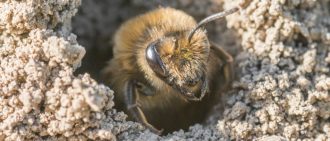

Be sure to read:
We suggest that you familiarize yourself with: Diseases transmitted by ticks to humans
How to get rid of earth bees: effective ways and methods, why are they dangerous?
After about a week, larvae begin to hatch from the eggs. Wasp nests come in a variety of lengths and shapes - some resemble a hemisphere with small hexagonal cells, others earthenware jars, or a discarded snake skin. When the queen dies, the older wasps take care of the growing larvae.
Bees fill the hives prepared by man with their honeycombs. The material for construction is wax secreted by special glands on the abdomen of insects.
The bees shape the wax into hexagonal cells. Honey will be stored in the combs, larvae will be able to develop. A bee colony consists of one queen, a large number of drones and thousands of worker insects. In this system, each bee has its own abilities and responsibilities, and she faithfully fulfills them.
In spring, new queens appear in bee hives, swarming takes place - separation of families. The old queen forms a new swarm and leaves the hive. She founds a new colony away from the old one. The responsibilities of worker bees are divided according to age. Young insects clean the hive and play the role of nurses. The older ones collect pollen and nectar from flowers.
Natural enemies of hornets
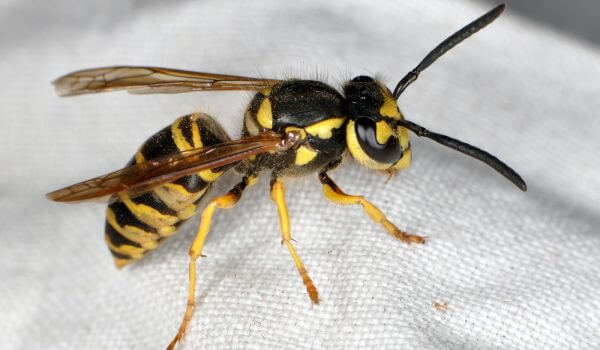

Photo: Hornet insect
Hornets don't have many natural enemies. This is due to the fact that these insects are relatively peaceful. They prefer to run away from the enemy. Only by defending itself can a hornet prove itself as a real hunter. Such animals are especially ferocious if someone coveted their nest, offspring, uterus. Also, a small number of natural enemies is explained by the venomousness of hornet wasps, as evidenced by their bright color. Other animals try to bypass such insects.
A number of natural enemies of hornets can be written:
- small parasites. Nematodes, riders, ticks slowly but surely kill large hornets, greatly undermine their health;
- some types of birds. Only a few species of birds are able to hunt representatives of social wasps. Most birds simply swallow them whole, preventing the insect from stinging itself;
- fungi. The fungus can germinate in a hornet in the head, lead it to a painful and long death;
- other insects. Hornets can be killed by larger wasps, ants.Ants most often feast on insect larvae;
- of people. Despite the benefits, hornets are considered pests. They settle in residential buildings, are quite dangerous to human health and life, and cause significant damage to young trees. For this reason, hornet nests are often destroyed by humans.
Relationship with a person


There is no doubt that the attitude of a person to industrious, from all sides useful bees, and to a much greater extent to aggressive wasps useless for people, varies greatly.
Bees have indeed been used by humans for a long time to obtain such valuable products of their vital activity as honey, propolis, wax; their poison is used in medicine.
The difference between a bee and a wasp.
Even in ancient times, honey was called the food of the gods, noting the amazing combination of its taste properties with such healing properties as restoration of strength and prolongation of life.
Propolis and wax are also the most valuable substances that have pronounced antibiotic properties and are widely used in pharmacology for the creation of many medicines.
Bee venom has been used for decades as a therapy for problems with the cardiovascular system, sleep disorders, treats rheumatic diseases, neuralgia, and generally mobilizes and improves immunity.
What can oppose such a set of wasps? In fact, quite a bit.
However, to a greater extent, this striped aggressor is associated in humans with a pest, which is also dangerous to health. Wasps often sting for no reason, attack bee hives, they also tend to gnaw holes in the peel of the fruit, thereby spoiling the harvest.
Who stings harder
And here we need to clarify the differences:
The toxins that are injected into the skin when bitten are used in medicine. There is even a separate area - apitoxin therapy. Wasps are less commonly used for treatment. However, their poison is being actively investigated. The use of such extreme therapy is limited only by serious allergic consequences for the human body.
Knowing these differences, behave accordingly when you encounter a wasp or a bee. In addition, having started getting rid of pests on the site, remember that by spraying plants with insecticides, you endanger the bees. Getting rid of wasps is not at all necessary - they also bring benefits. True, if their nest is nearby, then these are not the most pleasant and calm neighbors.
When to seek medical help


You must immediately call an ambulance if:
- In cases of multiple bites.
- When anaphylactic reactions appear.
- When a person is prone to allergies, but the necessary drugs are not at hand.
- When an insect has bitten on the tongue, in the face or eyes.
- If the victim is a child or a mother-to-be.
First aid rules
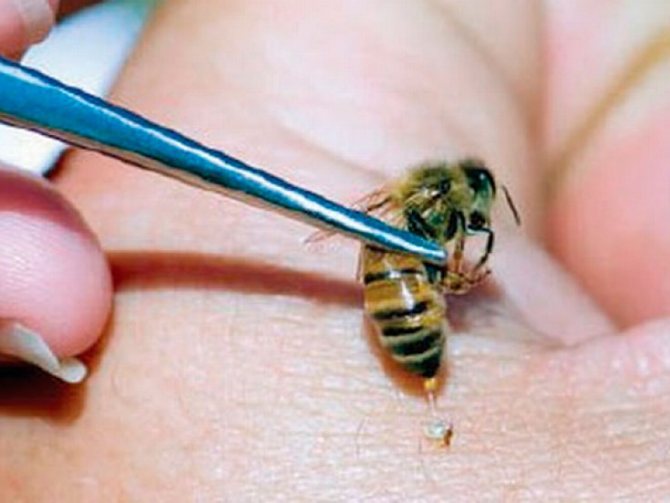

- Take the victim away from the place where he was bitten by a wasp or bee to a safe place.
- Pull out the sting if bitten by a bee using tweezers and moisten it with alcohol or cologne.
- The bite site is wiped with cold water or other disinfectant solution.
- If this happened far from home, in nature, then the bite site is washed with clean water, after which a plantain or dandelion leaf is applied to the bite site, which also need to be rinsed with clean water.
- A cold compress is applied to the wound to relieve discomfort and itching.
- The bite site is treated with drugs such as Fenistil-gel, Rescuer balm, etc. It is possible to use folk remedies such as aloe juice, chopped parsley and others.
- The victim must take an allergy pill.
- Give the victim to drink plain, mineral or bottled water without gas in order to quickly remove toxins from the body.
Bite difference
The difference between a bee and a wasp is also manifested in the behavior of representatives of both species when a threat arises.
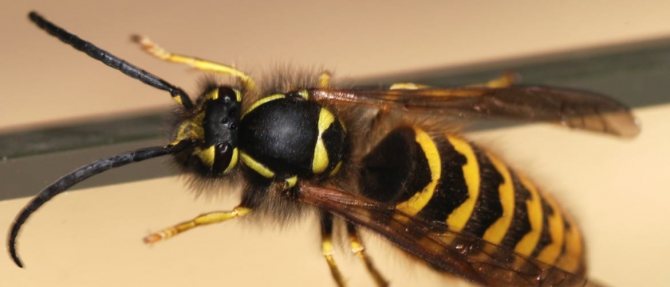

Indeed, it is common for bees to use their weapons only in the most extreme cases, when the insect is sure that either itself or its hive, which means the larvae and the queen, are in mortal danger. After all, a bee, as you know, dies after stinging an adversary, since its sting always remains at the injection site, and the stinging process itself inflicts injuries incompatible with life on the honey worker.
The wasp, on the other hand, has a different structure of its reduced ovipositor, which it can use many times without any threats to its health.
Also, the chemical composition of the venom of these species of Hymenoptera has some differences, although very insignificant. With a bee sting, the allergic reaction of the human body is still somewhat less obvious.
Sting features


A bee sting has its own characteristics: after a bee sting, the bee dies, since it cannot pull out the sting. It remains in the human body, along with part of the intestines. The sting is serrated, so it reliably adheres to human skin. In addition, human skin is quite elastic and resilient. After a wasp sting, the sting does not remain in the wound, and the wasp can bite several times. During a wasp bite, they use their jaws, thanks to which they bite through human skin.

